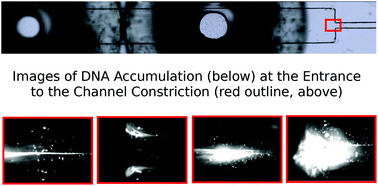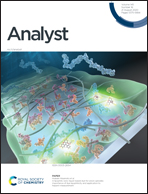Electro-hydrodynamic extraction of DNA from mixtures of DNA and bovine serum albumin†
Abstract
We report separation of genomic DNA (48 kbp) from bovine serum albumin (BSA) by the electro-hydrodynamic coupling between a pressure-driven flow and a parallel electric field. Electro-hydrodynamic extraction exploits this coupling to trap DNA molecules at the entrance of a microfluidic contraction channel, while allowing proteins and salts to be flushed from the device. Samples (10 μL) containing λ-DNA (1 ng) and BSA (0.3 mg) were injected directly into the device and convected to the contraction channel entrance by a flowing buffer solution. The DNA remains trapped in this region essentially indefinitely, while proteins and salts are eluted. The effectiveness of the concept has been assessed by fluorescence measurements of DNA and BSA concentrations. Electro-hydrodynamic extraction in a single-stage device was found to enhance the concentration of DNA 40-fold, while reducing the BSA concentration by four orders of magnitude. The relative concentrations of DNA to BSA at the contraction channel entrance can be as large as 1.5 : 1, corresponding to an A260/280 ratio of 1.9. The maximum yield of DNA from a salt-free solution is 50%, while salted (150 mM) solutions have a lower yield (38%).



 Please wait while we load your content...
Please wait while we load your content...
